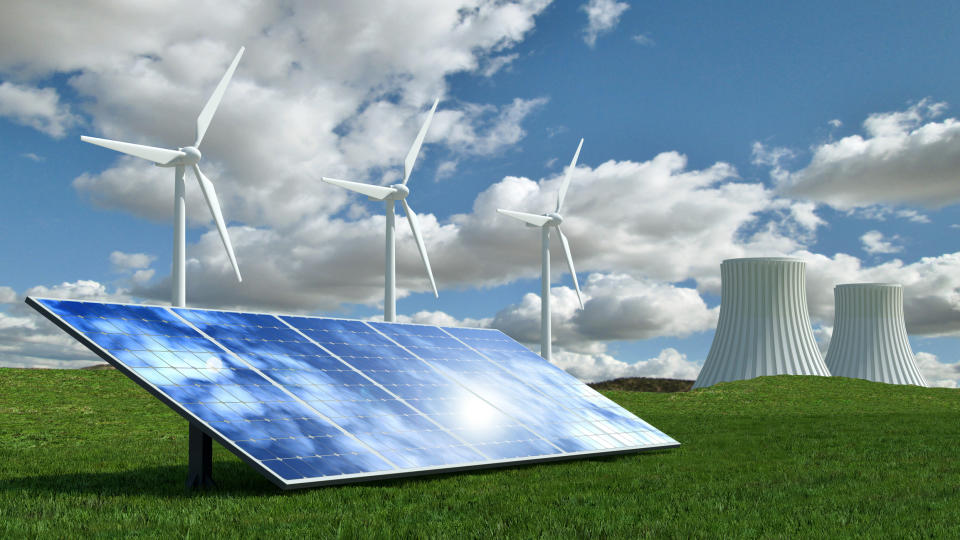Why Plug Power, SunPower, and Brookfield Renewable Stocks All Dropped Today

Monday is shaping up to be a be a bad day to own renewable energy stocks. Shares of hydroelectric, wind, and solar power plant operator Brookfield Renewable Energy (NYSE: BEPC) fell 4.1% through 11:20 a.m. ET, while smaller hydrogen company Plug Power (NASDAQ: PLUG) and solar power provider SunPower (NASDAQ: SPWR) sank 6.3% and 8.7%, respectively.
To find out why, let's open up the pages of USA Today's Sunday edition, which reported that "U.S. counties are blocking the future of renewable energy."
The vast potential of American renewable energy
This story starts out happy, with USA Today reminding readers that America is a potential renewable energy powerhouse (so to speak). Out of the 2.9 million square miles that comprise American territory, if we were to cover just 10,424 of those square miles -- about one-third of 1% of America's landmass -- with solar panels and wind turbines, this would generate enough clean energy to cover 100% of our electricity needs. And the Biden administration has proposed doing just that, setting a goal of generating 100% of America's energy from non-fossil fuel renewable energy sources by 2035 -- barely a decade away.
Now here's the bad news: According to the U.S. Energy Information Administration (EIA), we're not going to hit that goal.
Despite data showing that the cost per megawatt hour of producing utility-scale wind and solar power is now cheaper than producing power from coal, natural gas, or even nuclear power, a NIMBY (not in my backyard) movement is sweeping the country. In 2023, nearly as many counties passed legislation blocking new solar farms as began producing solar power within their bounds, while in 2022, more counties blocked wind farms than began producing it.
As of today, through a combination of moratoriums, bans, project permitting regulations, and other restrictions, new utility-scale solar and wind projects are effectively banned in 15% of U.S. counties. And these include some of the counties best situated for generating solar power (i.e., the sunny Southwest), as well as those best situated for generating wind power (i.e., the windy Midwest).
What does this mean for renewable energy stocks?
Now, it's not all bad news. While NIMBY movements are curtailing green energy development in 15% of U.S. counties, that still leaves the vast majority of the country open to development -- and new projects are being announced all the time. Plus, what can be banned can also be unbanned, if voters can be convinced that clean, cheap electricity might actually be a good thing -- good enough that they don't mind having a plant built right next door.
For today, however, renewable energy investors may be feeling like the wind has been taken out of their sails (so to speak). If you've been buying shares of Brookfield Renewable, for example, on the theory that it's a renewable energy utility, and in just 11 short years the whole U.S. is going to be renewable, well, it's probably depressing to hear EIA tell you that this is not, in fact, going to happen. It kind of blows up the investment thesis a little bit -- or at least delays it. Similar worries probably afflict you if you were betting on just the solar side of this thesis, and buying shares of SunPower.
I'm not as clear on why USA Today's renewable energy article would be worrying Plug Power shareholders today. The paper didn't say one word about hydrogen power or fuel cells, after all. Then again, in contrast to Brookfield and SunPower -- both of which were profitable as recently as 2022, and could become so again -- Plug Power is a kind of pie-in-the-sky stock that hasn't had a profitable year ever in its 27-year history.
As for buying opportunities, if you're inclined to look at today's trading action as an overreaction and a chance to buy and hold, of the three stocks named here, I think Brookfield probably has the most potential.
Even with its sizable debt load, the stock sells for an enterprise value only 17 times the profit it earned in 2022. And while (barely) unprofitable in 2023, Brookfield still managed to generate positive free cash flow of $572 million last year -- which was even more cash than it generated when "profitable" in 2022. (And growth is good.) Plus, with a portfolio of energy assets ranging from hydro to solar to wind, Brookfield gives you a more diversified bet on renewable energy in general.
To me, it seems to be the safest way to take advantage of the situation presenting itself today.
Should you invest $1,000 in Brookfield Renewable right now?
Before you buy stock in Brookfield Renewable, consider this:
The Motley Fool Stock Advisor analyst team just identified what they believe are the 10 best stocks for investors to buy now... and Brookfield Renewable wasn't one of them. The 10 stocks that made the cut could produce monster returns in the coming years.
Stock Advisor provides investors with an easy-to-follow blueprint for success, including guidance on building a portfolio, regular updates from analysts, and two new stock picks each month. The Stock Advisor service has more than tripled the return of S&P 500 since 2002*.
*Stock Advisor returns as of February 5, 2024
Rich Smith has no position in any of the stocks mentioned. The Motley Fool has positions in and recommends Brookfield Renewable. The Motley Fool has a disclosure policy.
Why Plug Power, SunPower, and Brookfield Renewable Stocks All Dropped Today was originally published by The Motley Fool
